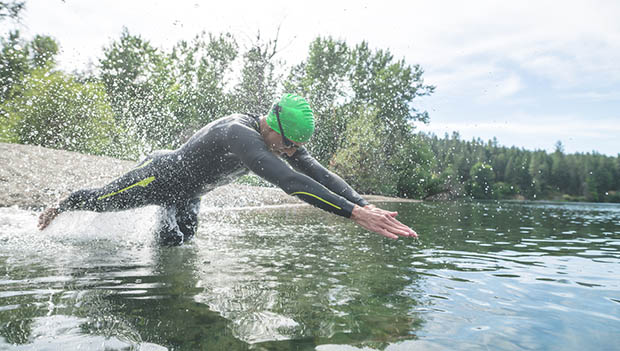
For swimmers who spend most of their training in the controlled environment of a pool, adjusting to the unpredictable open water can be a challenge.
Before you hit the open water, incorporate specific activities into your training to make the transition easier--and safer.
Of course, the best way to adjust is to swim in the open water as much as possible before heading out with a large group or participating in a triathlon with a mass start. Not only will you get to practice using large landmarks to swim straight, your workout won't be interrupted by stopping and turning at a wall.
Since most of us don't have that option, here are some easy-to-implement drills you can do in the pool to become a better open water swimmer. Best of all, you can do them without adding any additional time to your typical pool workout.
More: 7 Open Water Swimming Tips You Didn't Know
Move Away From the Wall
Deep-water starts are common in triathlons. Even if it's a beach start, you may stop to rest during the swim and need a way to quickly get back into a rhythm. Practice deep-water starts by moving a few yards away from the wall so you can't use it to push off.
Allow your body to settle somewhere between vertical and horizontal, just like you would right before the gun goes off. Take off quickly, get into your rhythm and swim at least a full lap before stopping. Do anywhere from 6 to 10 repetitions, at least once a week, in the last 6 to 8 weeks before your key race.
More: 8 Timesaving Tips to Improve Your Swim
Play with Some Speed
Fartlek, or speed play, is an excellent way to mimic what really happens during an open water swim. Whether you need to swim around a slower swimmer or pick up the pace to draft another person or group, it's easy to incorporate this into your regular training without adding time.
For example, during your long swim sessions, crank-up the pace for short bursts--anywhere from 25 to 100 yards--then settle back into your planned session pace. For the best results, start when you're away from the wall to simulate being in the open water as much as possible.
It's also a good idea to occasionally stop during one of these repeats, just like you might during your race. This way, you can practice a deep water start and speed play at the same time.
More: 50 Things Open Water Swimmers Shouldn't Do
Hold Your Head Up and Look
Unlike using the lane lines under the water in a pool, to swim straight in the open water, you have to use things above the water to get your bearings.
An easy way to do this is to throw a water polo ball or volleyball in the lane with you and lift your head to find it every 5 to 10 strokes. This teaches you how to quickly spot an object such as a course buoy, floating on the water. If you practice this regularly, you'll become more comfortable with lifting your head, sighting an object and getting back into a swim rhythm.
When you swim up on the ball, it's also a good idea to take a few strokes pushing the ball down the pool like you would in water polo. This requires you to keep your head up for a few strokes, which you will likely need to do in the open water when waves make it difficult to see the buoys.
Bonus Tip: Swimming with Other Racers
There's not much you can do to simulate bodies swimming around (and over) you, but there are some ways to get more comfortable swimming with groups. Try training with a water polo team, jumping in a crowded lane at your local masters swim group, joining a triathlon swim group, or even getting a couple of friends to swim next to you in the lane while you do laps.
If you can build these drills into your swim training 6 to 8 weeks before your next race, you'll arrive more confident for your open water start. Sometimes, just knowing you've trained for the unknowns can calm your mind and help you take on whatever the day delivers.
READ THIS NEXT: Everything You Need to Know Before Your First Triathlon Swim
 Find: Your Next Race
Find: Your Next Race


